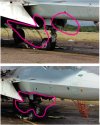The T-50 is a warplane and a feature of warplanes is that they can take knocks and damage and be repaired again in a reasonable time for a return to combat. Damage is a part of the design brief.
Why do people suppose the T-50 is different?
Well in actuality the T-50 has been designed to be different, much of the structure is carbon fibre likely bonded to a titanium spine, either with rivets, bolts, or more likely a bonding agent. Titanium is very difficult to weld, in fact welds are a critical area of failure of any titanium structure, carbon fibre as the name implies is a composite much like fiberglass only using the much stronger carbon fiber which is layered and bonded in the shape desired, and compressed in a mold under pressure to give it maximum strength by chasing out the voids, one of the secrets of its strength is this process?
I believe that the engine caught fire upon landing, if you recall at MAKs one of the T-50s had an engine event and fire on the runway on take-off, the take off was aborted and the engine fire contained, all engines have a fire suppression device, as turbines do get very hot. The T-50 in particular is pushing the F-117, and nothing wrong with that. As we saw from the F-135 fire on the F-35, it was caused by the chaffing of the turbine, on its outer housing, these things happen.
My point is as Deino has well stated that a fire, which was as well developed as the one on T-50 dash 055 has likely caused a very extensive delamination of those wonderful carbon fibre, and a very definite change in the molecular structure of the supporting spine, stringers, and ribs that it is bonded to. I had already suggested that the T-50 would probably use the undamaged nose, tail, wings, and any other undamaged structure and attached to a new center section, fuselage, which is the most efficient and cost effective manner to repair damage of this nature. The T-50 structure has been designed and built to be both light and strong, what happens when you push the envelope in this manner is that you may and in fact in the T-50s case, we know they have ended up with some structural issues, hence the exterior longerons bonded to the T-50s horizontal stabilizers. Not a bit different than what we have ended up with the F-35B by substituting an aluminum allow, for the designed Titanium Bulkhead that carriers the heavy structure , we also have cracks that will continue to be dealt with, all in the desire to save some weight, and make no mistake, the weight saving game is played by every fighter designer, car designer and even bicycle designers.

